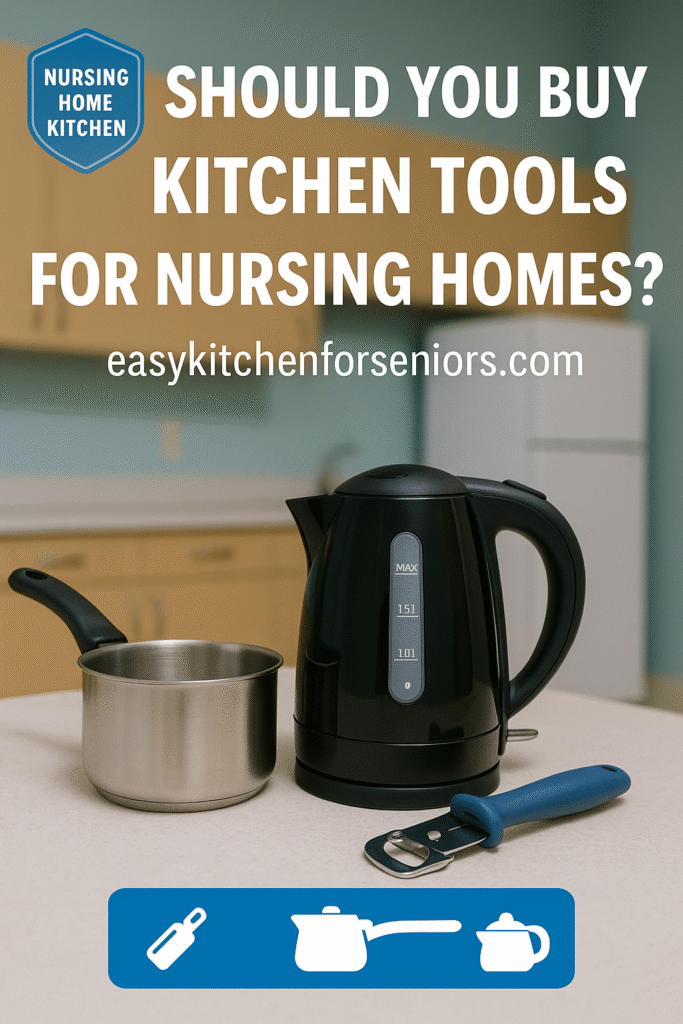Should You Buy Kitchen Tools for Nursing Homes?
If you’re helping a parent or loved one transition into a nursing home in 2025, you may be wondering: should you buy extra kitchen tools to make daily life easier? The short answer is “sometimes”—but it depends on the home’s policies, the resident’s level of independence, and what will genuinely improve safety and comfort. Many facilities provide shared kitchenettes or supervised dining areas, yet small, senior-friendly items can still make a big difference: large-handle utensils for arthritic hands, spill-proof cups for tremors, or a compact, easy-to-wipe cutting board for light snack prep. The goal is to support dignity and autonomy without creating clutter or safety risks.
In this guide, we’ll walk you through what’s appropriate to bring, what to avoid, and how to pick items that are safe, simple, and facility-approved. We’ll focus on “elderly kitchen” essentials that are for seniors: lightweight tools, big labels and high-contrast markings for low vision, and devices with built-in safety features (like auto-shutoff) when permitted. Whether you’re choosing a one-touch electric kettle or a nonslip tray, we’ll help you match tools to the resident’s abilities and your nursing home’s rules—so every purchase actually gets used.
Disclosure: This post contains affiliate links. As an Amazon Associate, we may earn from qualifying purchases at no extra cost to you. We only recommend products that meet senior-friendly criteria for safety and ease of use.
Quick Picks: Senior-Friendly Kitchen Tools
- Easy one-touch use (should you buy?)
- Non-slip, low-effort handling
- Great for “elderly kitchen” setups
- Lightweight, simple controls
- High-contrast markings for low vision
- Easy to clean; compact for nursing rooms
- Large grips for weak hands
- Low-noise operation, safer for seniors
- Durable, dishwasher-friendly
2📎Comparison Table: Kitchen Tools for Nursing Homes
| Product | Type | Key Features | Why | Buy it now |
|---|---|---|---|---|
| Automatic Electric Jar Opener | Senior-friendly kitchen tool |
| Great for weak grip or arthritis; reduces strain and slips. | |
| Lightweight Electric Kettle (Small) | Senior-friendly kitchen tool |
| Safer hot-drink prep in small nursing-home rooms. | |
| Weighted Utensils Set (Spoon/Fork/Knife) | Senior-friendly kitchen tool |
| Helps reduce tremors and improve control at mealtime. | |
| Easy-Grip Can Opener (Electric) | Senior-friendly kitchen tool |
| Less wrist twist; safer lid edges for seniors. | |
| Non-Slip Cutting Board (Small) | Senior-friendly kitchen tool |
| Prevents sliding; clearer edges for low vision. | |
| OXO Good Grips Jar Opener | Senior-friendly kitchen tool |
| Low-effort manual option; reliable brand for seniors. | |
| Anti-Spill Drinking Cup with Lid | Senior-friendly kitchen tool |
| Reduces mess and choking risk; easier hydration. |
3) Detailed Reviews
Automatic Electric Jar Opener
Why it’s worth considering: Minimizes wrist twist and grip strength—two motions that challenge residents with arthritis or tremors. If your facility allows small, non-corded devices in rooms, this is a quick independence boost.
- Pros: One-touch start/stop; fits many lid sizes; compact and light.
- Cons: Uses batteries; not ideal for very small diameter lids.
Best for: Seniors with weak grip who want to open jars safely without staff assistance.
Lightweight Electric Kettle (Small, Auto-Shutoff)
Why it’s worth considering: If permitted, a small kettle with auto-shutoff supports safer tea or oatmeal prep. Look for easy-read water windows and a drip-resistant spout to reduce spills.
- Pros: Auto-shutoff; clear water window; easy-pour; compact footprint.
- Cons: Some homes restrict heated appliances—confirm policy first.
Best for: Residents who enjoy warm drinks and have staff approval for low-risk appliances.
Weighted Utensils Set (Spoon/Fork/Knife)
Why it’s worth considering: Added handle weight dampens tremors, making self-feeding less frustrating. Non-slip grips and dishwasher-safe parts keep maintenance simple.
- Pros: Improves control; non-slip handles; dishwasher-safe.
- Cons: Heavier than standard flatware—may tire users with low arm strength.
Best for: Seniors with Parkinson’s or essential tremor seeking steadier utensil handling.
Easy-Grip Electric Can Opener (Smooth-Edge)
Why it’s worth considering: Smooth-edge cutting reduces nick risk, and push-button controls remove wrist twisting. Works well for supervised snack prep in a shared kitchenette.
- Pros: One-button; safer smooth edges; compact design.
- Cons: Needs an outlet; may be limited to common areas.
Best for: Residents who frequently open canned fruit, soups, or broth.
Non-Slip Cutting Board (Small)
Why it’s worth considering: Textured feet and a juice groove reduce sliding and help contain crumbs. High-contrast color options make edges easier to see for low-vision users.
- Pros: Stable feet; easy-clean surface; space-saving size.
- Cons: Not intended for heavy chopping—best for light snack prep.
Best for: Residents preparing simple snacks under supervision or in approved areas.
OXO Good Grips Jar Opener (Manual)
Why it’s worth considering: When batteries or outlets aren’t practical, a manual opener with a non-slip base provides leverage without strain. Low-tech and staff-friendly.
- Pros: No power needed; ergonomic; compact; trusted brand.
- Cons: Requires a small amount of hand pressure to start the grip.
Best for: Residents who prefer simple tools and open jars occasionally.
Anti-Spill Drinking Cup with Lid
Why it’s worth considering: Hydration is a common challenge in nursing homes. A leak-resistant cup with an easy-sip lid cuts mess and choking risk while preserving dignity in shared dining areas.
- Pros: Spill-resistant; lightweight; straw-friendly; easy to clean.
- Cons: Some users prefer larger capacity—match to drinking habits.
Best for: Seniors with shaky hands or those who need safer sipping in transit to lounges or activities.
4) Buying Guide 2025: How to Choose Nursing-Home Kitchen Tools (for Seniors)
Before you hit “Buy,” confirm the facility policy. Every nursing home treats small appliances, sharp tools, and plug-in devices differently. Once you clear that step, prioritize safety, simplicity, and whether the tool actually solves a daily problem in an elderly kitchen—a simplified, low-effort setup for seniors who value independence and dignity.
- Ask if small plug-in items (e.g., kettle, can opener) are allowed in private rooms or only in supervised kitchenettes.
- Clarify rules for battery-powered vs. plug-in tools and any required auto-shutoff features.
- Confirm cleaning and storage expectations with staff to fit care routines in 2025.
- Provide a one-page instruction card if the tool has unusual steps or settings.
Safety First (for Seniors)
- Auto-shutoff & locks: If approved, choose kettles and openers with auto-shutoff and covered blades.
- Non-slip & stable: Rubber feet, textured grips, and weighted bases that resist tipping in an elderly kitchen.
- Smooth edges: Can openers that leave smooth-edge lids reduce nick risks during cleanup.
- Spill control: Lidded cups and trays with raised lips; compact cutting boards with juice grooves.
Ease of Use (Elderly Kitchen)
- One-touch controls: Big buttons, minimal steps, obvious start/stop. Avoid complex multi-mode gadgets.
- Low effort: Wide handles, leverage aids, or automatic helpers (jar/can openers) for weak grip.
- High-contrast markings: Dark text on light backgrounds (or vice versa) for low vision.
- Low noise: Quiet tools prevent anxiety in shared spaces and during rest periods.
Right Size, Right Place
- Compact footprint: Choose small, lightweight tools that fit drawers or kitchenette shelves.
- Cord length & reach: Tidy, short cords reduce tangles; battery options remove outlet clutter.
- Labeled caddy: Use a small bin with labels so both staff and residents know where items belong.
Maintenance & Hygiene (2025)
- Dishwasher-safe parts: Fewer crevices = faster, more hygienic cleaning.
- Replaceables: Check battery sizes, gaskets, and where to find replacement lids or pads.
- Easy wipe-downs: Smooth, non-porous surfaces for quick daily cleaning.
Match the Tool to the Resident
- Cognition: If memory is a concern, stick to single-purpose, familiar tools with clear icons.
- Vision: Bold colors and large type; avoid glossy labels that glare under overhead lights.
- Dexterity: Wide handles, wrist-neutral motions, press-to-start operation.
- Hydration: If spills reduce intake, a spill-resistant cup may matter more than any gadget.
Coordinate with Care Staff
- Introduce the tool to the nurse or aide who supports meals and snacks.
- Leave a quick card: when to use it, where it’s stored, and how to clean it—friendly for seniors and staff.
- Review after one week: Is it used daily? If not, adjust or swap for a better fit.
Want a deeper dive into low-risk hot-drink prep? See: Best Electric Kettles with Auto Shutoff for Seniors .
5) FAQ
Should I buy kitchen tools before my parent moves in?
Which items are usually allowed for seniors in private rooms?
Are electric kettles safe for nursing homes in 2025?
What if my loved one has arthritis or weak grip?
How do I keep tools hygienic in a shared environment?
Battery-powered or plug-in—what’s better?
How can I make tools easier to see for low vision?
What’s a simple starter list that rarely goes wrong?
6) Conclusion: Should You Buy?
In 2025, the best answer is: buy selectively. Start with the facility’s policy, then choose simple, safe tools that your loved one will actually use in an elderly kitchen setup. If a product reduces spills, strain, or confusion—and it’s approved—it can be a small, meaningful boost to dignity for seniors.
Our top picks below cover everyday needs (opening jars/cans, safe sipping, quick hot drinks). If your nursing home limits plug-ins, focus on manual or battery-powered options first, then add an approved electric helper later.
Want more quiet, low-effort ideas? See our guide: 5 Quietest Kitchen Appliances for Seniors in 2025 .








